MA619 Accounting Research: AIS, E-Accounting & Growth in Australia
VerifiedAdded on 2023/06/11
|58
|8644
|427
Report
AI Summary
This report investigates the impact of Accounting Information Systems (AIS) and e-accounting on business growth, particularly within the Australian mining industry. It explores how these systems facilitate better decision-making, improve organizational efficiency, and enhance financial reporting. The research employs both qualitative and quantitative methods, including surveys and statistical analysis, to assess the relationship between AIS implementation and organizational performance. The findings suggest that AIS plays a critical role in timely and accurate reporting, contributing significantly to the efficiency and strategic management of mining companies. The report also delves into specific aspects of AIS usage, such as software applications, data analysis techniques, and the role of IT support, to provide a comprehensive understanding of its impact on the mining sector's financial and operational landscape. The study concludes by highlighting the limitations of the research and offering recommendations for future investigations.
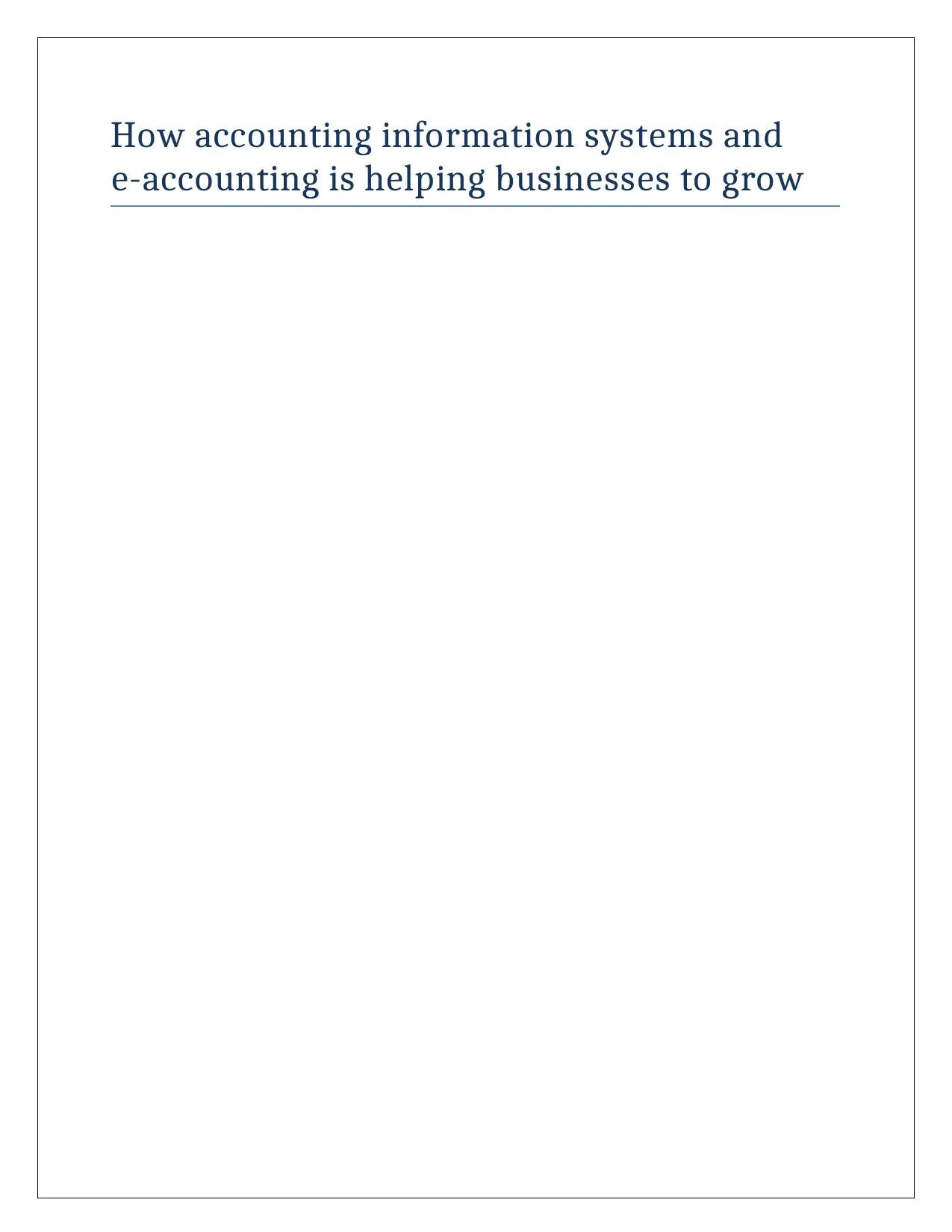
How accounting information systems and
e-accounting is helping businesses to grow
e-accounting is helping businesses to grow
Paraphrase This Document
Need a fresh take? Get an instant paraphrase of this document with our AI Paraphraser
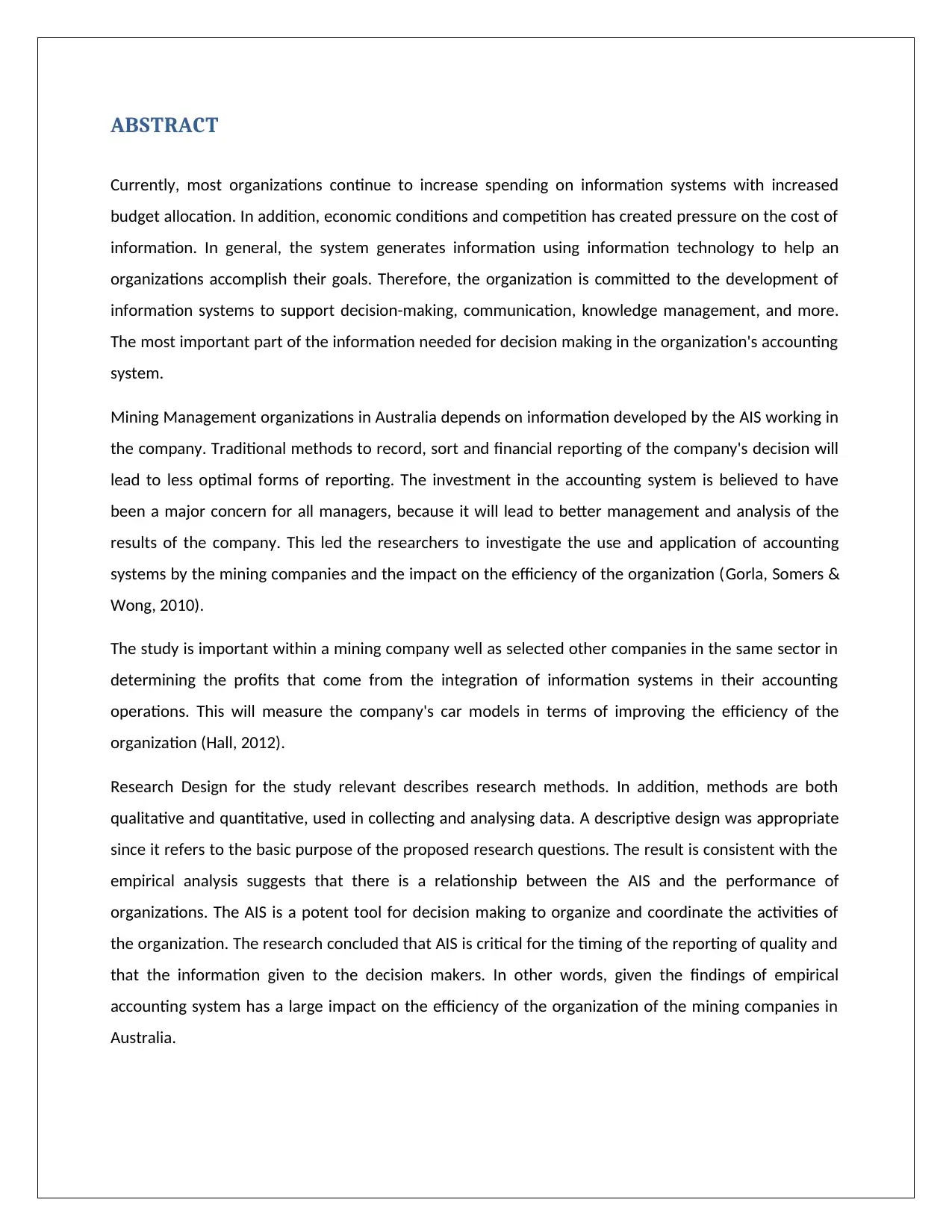
ABSTRACT
Currently, most organizations continue to increase spending on information systems with increased
budget allocation. In addition, economic conditions and competition has created pressure on the cost of
information. In general, the system generates information using information technology to help an
organizations accomplish their goals. Therefore, the organization is committed to the development of
information systems to support decision-making, communication, knowledge management, and more.
The most important part of the information needed for decision making in the organization's accounting
system.
Mining Management organizations in Australia depends on information developed by the AIS working in
the company. Traditional methods to record, sort and financial reporting of the company's decision will
lead to less optimal forms of reporting. The investment in the accounting system is believed to have
been a major concern for all managers, because it will lead to better management and analysis of the
results of the company. This led the researchers to investigate the use and application of accounting
systems by the mining companies and the impact on the efficiency of the organization (Gorla, Somers &
Wong, 2010).
The study is important within a mining company well as selected other companies in the same sector in
determining the profits that come from the integration of information systems in their accounting
operations. This will measure the company's car models in terms of improving the efficiency of the
organization (Hall, 2012).
Research Design for the study relevant describes research methods. In addition, methods are both
qualitative and quantitative, used in collecting and analysing data. A descriptive design was appropriate
since it refers to the basic purpose of the proposed research questions. The result is consistent with the
empirical analysis suggests that there is a relationship between the AIS and the performance of
organizations. The AIS is a potent tool for decision making to organize and coordinate the activities of
the organization. The research concluded that AIS is critical for the timing of the reporting of quality and
that the information given to the decision makers. In other words, given the findings of empirical
accounting system has a large impact on the efficiency of the organization of the mining companies in
Australia.
Currently, most organizations continue to increase spending on information systems with increased
budget allocation. In addition, economic conditions and competition has created pressure on the cost of
information. In general, the system generates information using information technology to help an
organizations accomplish their goals. Therefore, the organization is committed to the development of
information systems to support decision-making, communication, knowledge management, and more.
The most important part of the information needed for decision making in the organization's accounting
system.
Mining Management organizations in Australia depends on information developed by the AIS working in
the company. Traditional methods to record, sort and financial reporting of the company's decision will
lead to less optimal forms of reporting. The investment in the accounting system is believed to have
been a major concern for all managers, because it will lead to better management and analysis of the
results of the company. This led the researchers to investigate the use and application of accounting
systems by the mining companies and the impact on the efficiency of the organization (Gorla, Somers &
Wong, 2010).
The study is important within a mining company well as selected other companies in the same sector in
determining the profits that come from the integration of information systems in their accounting
operations. This will measure the company's car models in terms of improving the efficiency of the
organization (Hall, 2012).
Research Design for the study relevant describes research methods. In addition, methods are both
qualitative and quantitative, used in collecting and analysing data. A descriptive design was appropriate
since it refers to the basic purpose of the proposed research questions. The result is consistent with the
empirical analysis suggests that there is a relationship between the AIS and the performance of
organizations. The AIS is a potent tool for decision making to organize and coordinate the activities of
the organization. The research concluded that AIS is critical for the timing of the reporting of quality and
that the information given to the decision makers. In other words, given the findings of empirical
accounting system has a large impact on the efficiency of the organization of the mining companies in
Australia.
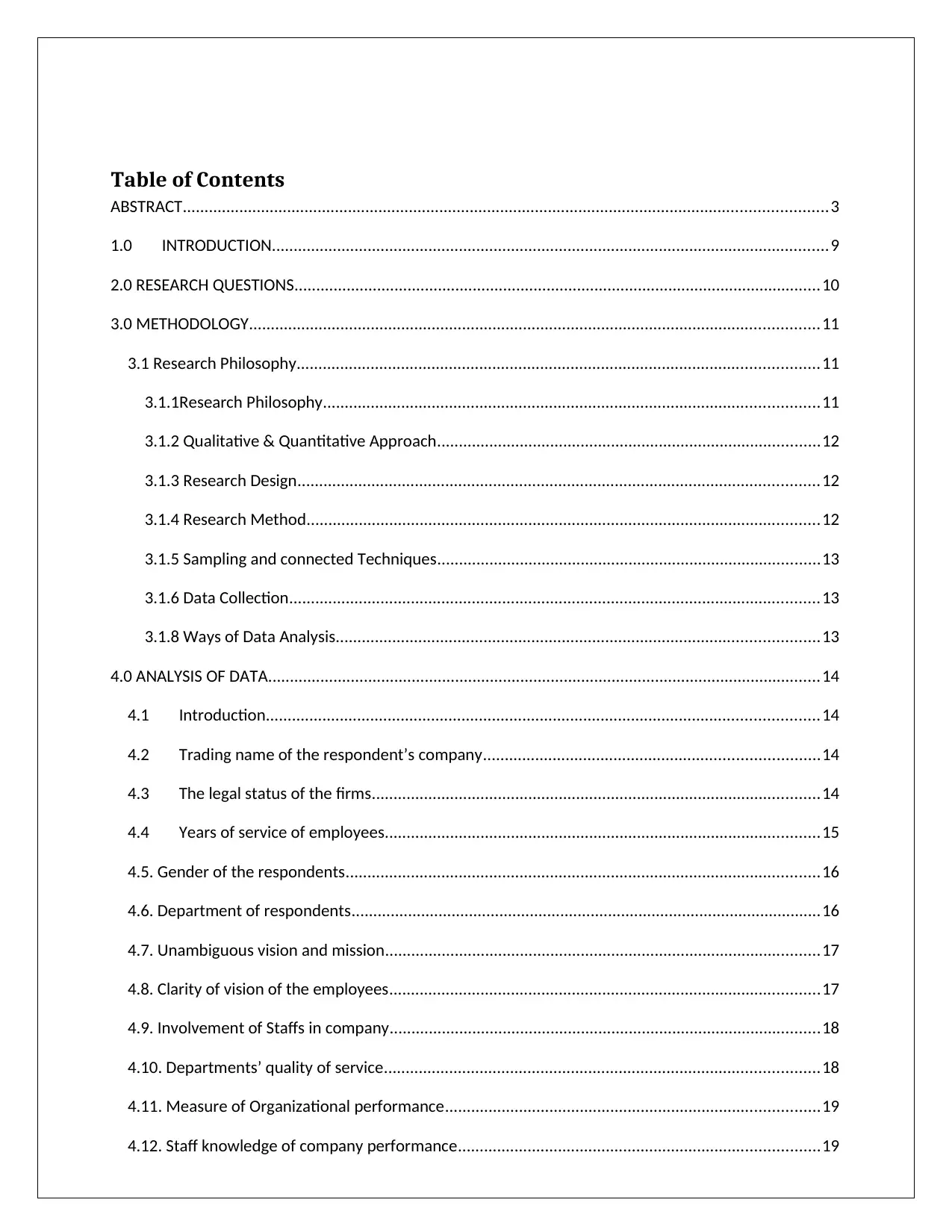
Table of Contents
ABSTRACT....................................................................................................................................................3
1.0 INTRODUCTION................................................................................................................................9
2.0 RESEARCH QUESTIONS.........................................................................................................................10
3.0 METHODOLOGY...................................................................................................................................11
3.1 Research Philosophy........................................................................................................................11
3.1.1Research Philosophy..................................................................................................................11
3.1.2 Qualitative & Quantitative Approach........................................................................................12
3.1.3 Research Design........................................................................................................................12
3.1.4 Research Method......................................................................................................................12
3.1.5 Sampling and connected Techniques........................................................................................13
3.1.6 Data Collection..........................................................................................................................13
3.1.8 Ways of Data Analysis...............................................................................................................13
4.0 ANALYSIS OF DATA...............................................................................................................................14
4.1 Introduction...............................................................................................................................14
4.2 Trading name of the respondent’s company.............................................................................14
4.3 The legal status of the firms.......................................................................................................14
4.4 Years of service of employees....................................................................................................15
4.5. Gender of the respondents.............................................................................................................16
4.6. Department of respondents............................................................................................................16
4.7. Unambiguous vision and mission....................................................................................................17
4.8. Clarity of vision of the employees...................................................................................................17
4.9. Involvement of Staffs in company...................................................................................................18
4.10. Departments’ quality of service....................................................................................................18
4.11. Measure of Organizational performance......................................................................................19
4.12. Staff knowledge of company performance...................................................................................19
ABSTRACT....................................................................................................................................................3
1.0 INTRODUCTION................................................................................................................................9
2.0 RESEARCH QUESTIONS.........................................................................................................................10
3.0 METHODOLOGY...................................................................................................................................11
3.1 Research Philosophy........................................................................................................................11
3.1.1Research Philosophy..................................................................................................................11
3.1.2 Qualitative & Quantitative Approach........................................................................................12
3.1.3 Research Design........................................................................................................................12
3.1.4 Research Method......................................................................................................................12
3.1.5 Sampling and connected Techniques........................................................................................13
3.1.6 Data Collection..........................................................................................................................13
3.1.8 Ways of Data Analysis...............................................................................................................13
4.0 ANALYSIS OF DATA...............................................................................................................................14
4.1 Introduction...............................................................................................................................14
4.2 Trading name of the respondent’s company.............................................................................14
4.3 The legal status of the firms.......................................................................................................14
4.4 Years of service of employees....................................................................................................15
4.5. Gender of the respondents.............................................................................................................16
4.6. Department of respondents............................................................................................................16
4.7. Unambiguous vision and mission....................................................................................................17
4.8. Clarity of vision of the employees...................................................................................................17
4.9. Involvement of Staffs in company...................................................................................................18
4.10. Departments’ quality of service....................................................................................................18
4.11. Measure of Organizational performance......................................................................................19
4.12. Staff knowledge of company performance...................................................................................19
⊘ This is a preview!⊘
Do you want full access?
Subscribe today to unlock all pages.

Trusted by 1+ million students worldwide
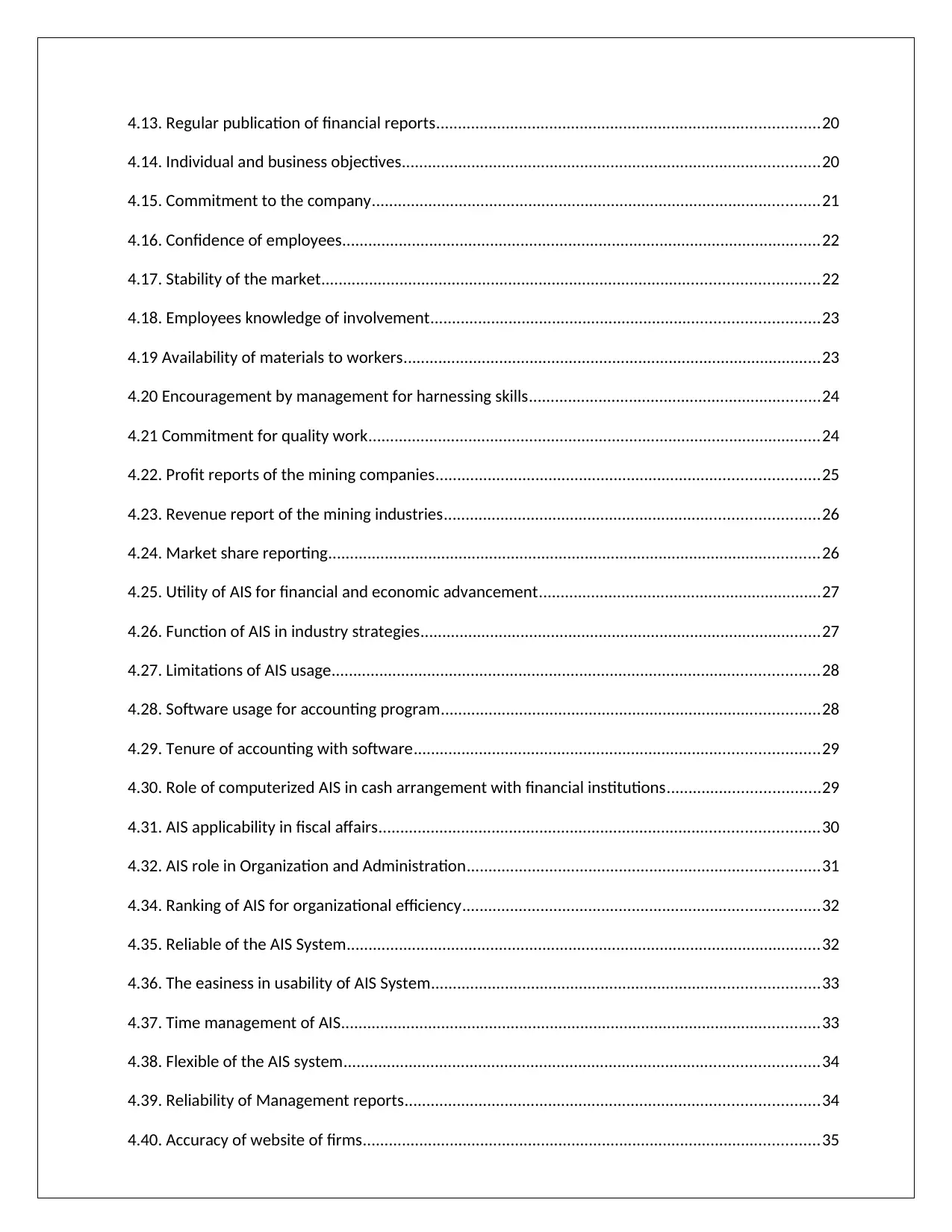
4.13. Regular publication of financial reports........................................................................................20
4.14. Individual and business objectives................................................................................................20
4.15. Commitment to the company.......................................................................................................21
4.16. Confidence of employees..............................................................................................................22
4.17. Stability of the market..................................................................................................................22
4.18. Employees knowledge of involvement.........................................................................................23
4.19 Availability of materials to workers................................................................................................23
4.20 Encouragement by management for harnessing skills...................................................................24
4.21 Commitment for quality work........................................................................................................24
4.22. Profit reports of the mining companies........................................................................................25
4.23. Revenue report of the mining industries......................................................................................26
4.24. Market share reporting.................................................................................................................26
4.25. Utility of AIS for financial and economic advancement.................................................................27
4.26. Function of AIS in industry strategies............................................................................................27
4.27. Limitations of AIS usage................................................................................................................28
4.28. Software usage for accounting program.......................................................................................28
4.29. Tenure of accounting with software.............................................................................................29
4.30. Role of computerized AIS in cash arrangement with financial institutions...................................29
4.31. AIS applicability in fiscal affairs.....................................................................................................30
4.32. AIS role in Organization and Administration.................................................................................31
4.34. Ranking of AIS for organizational efficiency..................................................................................32
4.35. Reliable of the AIS System.............................................................................................................32
4.36. The easiness in usability of AIS System.........................................................................................33
4.37. Time management of AIS..............................................................................................................33
4.38. Flexible of the AIS system.............................................................................................................34
4.39. Reliability of Management reports...............................................................................................34
4.40. Accuracy of website of firms.........................................................................................................35
4.14. Individual and business objectives................................................................................................20
4.15. Commitment to the company.......................................................................................................21
4.16. Confidence of employees..............................................................................................................22
4.17. Stability of the market..................................................................................................................22
4.18. Employees knowledge of involvement.........................................................................................23
4.19 Availability of materials to workers................................................................................................23
4.20 Encouragement by management for harnessing skills...................................................................24
4.21 Commitment for quality work........................................................................................................24
4.22. Profit reports of the mining companies........................................................................................25
4.23. Revenue report of the mining industries......................................................................................26
4.24. Market share reporting.................................................................................................................26
4.25. Utility of AIS for financial and economic advancement.................................................................27
4.26. Function of AIS in industry strategies............................................................................................27
4.27. Limitations of AIS usage................................................................................................................28
4.28. Software usage for accounting program.......................................................................................28
4.29. Tenure of accounting with software.............................................................................................29
4.30. Role of computerized AIS in cash arrangement with financial institutions...................................29
4.31. AIS applicability in fiscal affairs.....................................................................................................30
4.32. AIS role in Organization and Administration.................................................................................31
4.34. Ranking of AIS for organizational efficiency..................................................................................32
4.35. Reliable of the AIS System.............................................................................................................32
4.36. The easiness in usability of AIS System.........................................................................................33
4.37. Time management of AIS..............................................................................................................33
4.38. Flexible of the AIS system.............................................................................................................34
4.39. Reliability of Management reports...............................................................................................34
4.40. Accuracy of website of firms.........................................................................................................35
Paraphrase This Document
Need a fresh take? Get an instant paraphrase of this document with our AI Paraphraser
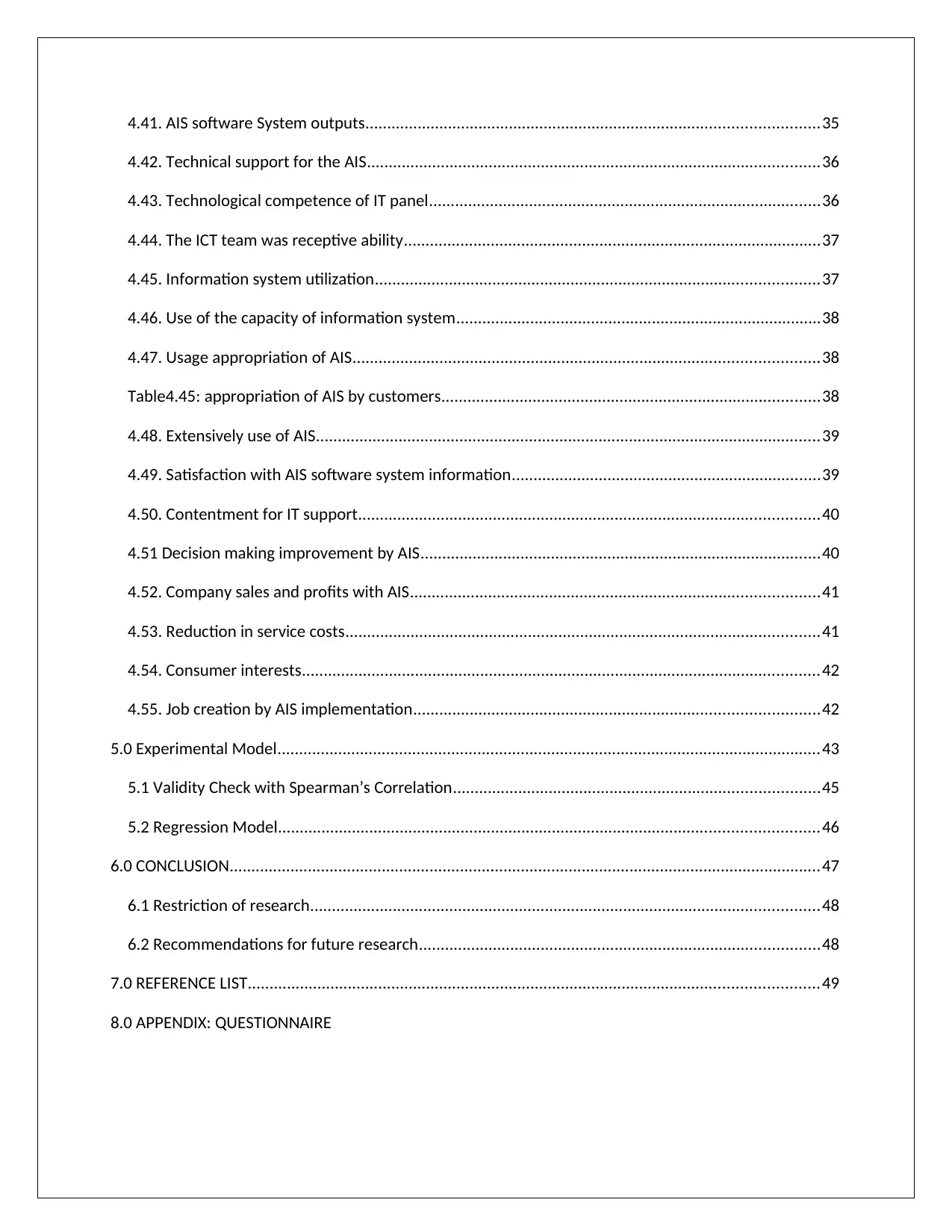
4.41. AIS software System outputs........................................................................................................35
4.42. Technical support for the AIS........................................................................................................36
4.43. Technological competence of IT panel..........................................................................................36
4.44. The ICT team was receptive ability................................................................................................37
4.45. Information system utilization......................................................................................................37
4.46. Use of the capacity of information system....................................................................................38
4.47. Usage appropriation of AIS...........................................................................................................38
Table4.45: appropriation of AIS by customers.......................................................................................38
4.48. Extensively use of AIS....................................................................................................................39
4.49. Satisfaction with AIS software system information.......................................................................39
4.50. Contentment for IT support..........................................................................................................40
4.51 Decision making improvement by AIS............................................................................................40
4.52. Company sales and profits with AIS..............................................................................................41
4.53. Reduction in service costs.............................................................................................................41
4.54. Consumer interests.......................................................................................................................42
4.55. Job creation by AIS implementation.............................................................................................42
5.0 Experimental Model.............................................................................................................................43
5.1 Validity Check with Spearman’s Correlation....................................................................................45
5.2 Regression Model............................................................................................................................46
6.0 CONCLUSION........................................................................................................................................47
6.1 Restriction of research.....................................................................................................................48
6.2 Recommendations for future research............................................................................................48
7.0 REFERENCE LIST...................................................................................................................................49
8.0 APPENDIX: QUESTIONNAIRE
4.42. Technical support for the AIS........................................................................................................36
4.43. Technological competence of IT panel..........................................................................................36
4.44. The ICT team was receptive ability................................................................................................37
4.45. Information system utilization......................................................................................................37
4.46. Use of the capacity of information system....................................................................................38
4.47. Usage appropriation of AIS...........................................................................................................38
Table4.45: appropriation of AIS by customers.......................................................................................38
4.48. Extensively use of AIS....................................................................................................................39
4.49. Satisfaction with AIS software system information.......................................................................39
4.50. Contentment for IT support..........................................................................................................40
4.51 Decision making improvement by AIS............................................................................................40
4.52. Company sales and profits with AIS..............................................................................................41
4.53. Reduction in service costs.............................................................................................................41
4.54. Consumer interests.......................................................................................................................42
4.55. Job creation by AIS implementation.............................................................................................42
5.0 Experimental Model.............................................................................................................................43
5.1 Validity Check with Spearman’s Correlation....................................................................................45
5.2 Regression Model............................................................................................................................46
6.0 CONCLUSION........................................................................................................................................47
6.1 Restriction of research.....................................................................................................................48
6.2 Recommendations for future research............................................................................................48
7.0 REFERENCE LIST...................................................................................................................................49
8.0 APPENDIX: QUESTIONNAIRE
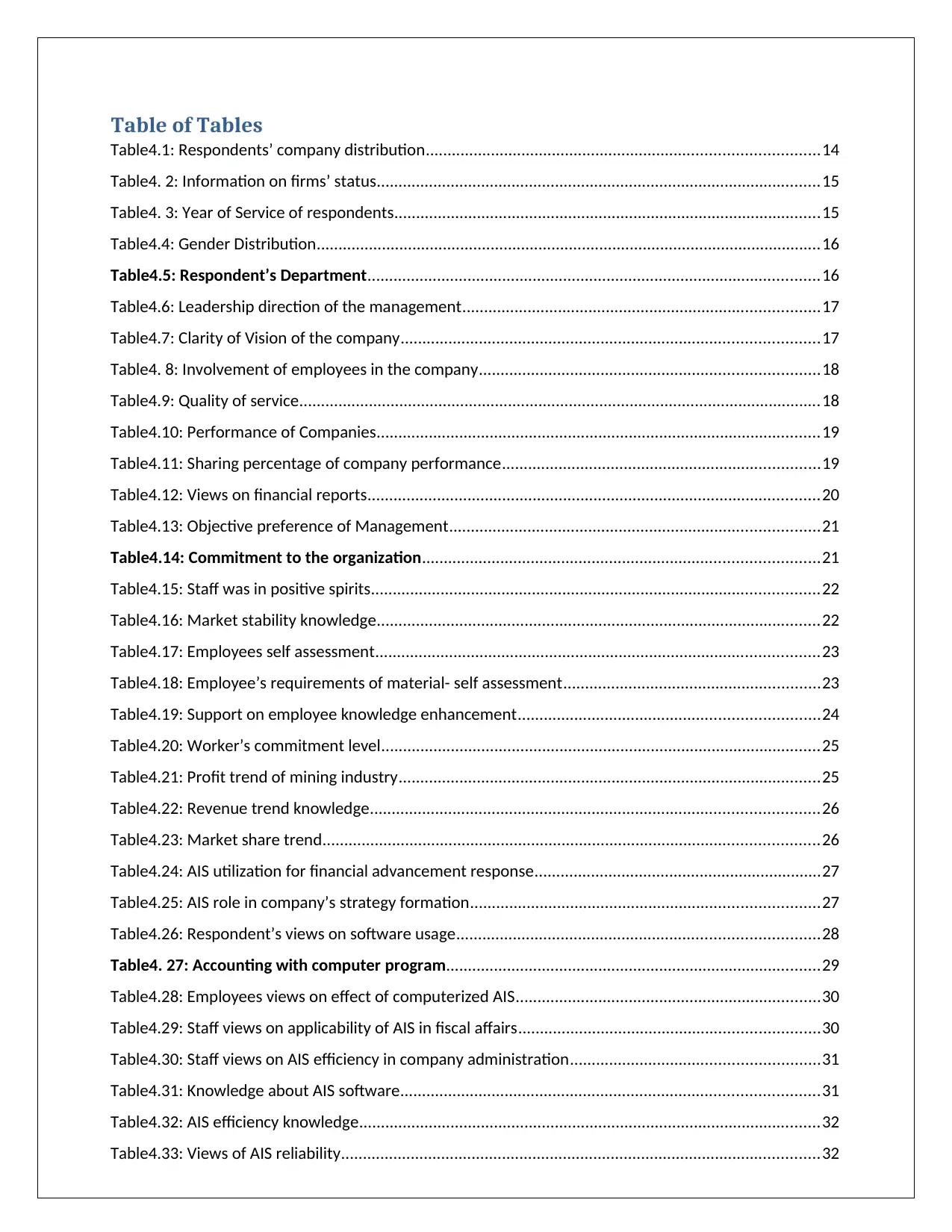
Table of Tables
Table4.1: Respondents’ company distribution..........................................................................................14
Table4. 2: Information on firms’ status......................................................................................................15
Table4. 3: Year of Service of respondents..................................................................................................15
Table4.4: Gender Distribution....................................................................................................................16
Table4.5: Respondent’s Department........................................................................................................16
Table4.6: Leadership direction of the management..................................................................................17
Table4.7: Clarity of Vision of the company................................................................................................17
Table4. 8: Involvement of employees in the company..............................................................................18
Table4.9: Quality of service........................................................................................................................18
Table4.10: Performance of Companies......................................................................................................19
Table4.11: Sharing percentage of company performance.........................................................................19
Table4.12: Views on financial reports........................................................................................................20
Table4.13: Objective preference of Management.....................................................................................21
Table4.14: Commitment to the organization...........................................................................................21
Table4.15: Staff was in positive spirits.......................................................................................................22
Table4.16: Market stability knowledge......................................................................................................22
Table4.17: Employees self assessment......................................................................................................23
Table4.18: Employee’s requirements of material- self assessment...........................................................23
Table4.19: Support on employee knowledge enhancement.....................................................................24
Table4.20: Worker’s commitment level.....................................................................................................25
Table4.21: Profit trend of mining industry.................................................................................................25
Table4.22: Revenue trend knowledge.......................................................................................................26
Table4.23: Market share trend..................................................................................................................26
Table4.24: AIS utilization for financial advancement response..................................................................27
Table4.25: AIS role in company’s strategy formation................................................................................27
Table4.26: Respondent’s views on software usage...................................................................................28
Table4. 27: Accounting with computer program......................................................................................29
Table4.28: Employees views on effect of computerized AIS......................................................................30
Table4.29: Staff views on applicability of AIS in fiscal affairs.....................................................................30
Table4.30: Staff views on AIS efficiency in company administration.........................................................31
Table4.31: Knowledge about AIS software................................................................................................31
Table4.32: AIS efficiency knowledge..........................................................................................................32
Table4.33: Views of AIS reliability..............................................................................................................32
Table4.1: Respondents’ company distribution..........................................................................................14
Table4. 2: Information on firms’ status......................................................................................................15
Table4. 3: Year of Service of respondents..................................................................................................15
Table4.4: Gender Distribution....................................................................................................................16
Table4.5: Respondent’s Department........................................................................................................16
Table4.6: Leadership direction of the management..................................................................................17
Table4.7: Clarity of Vision of the company................................................................................................17
Table4. 8: Involvement of employees in the company..............................................................................18
Table4.9: Quality of service........................................................................................................................18
Table4.10: Performance of Companies......................................................................................................19
Table4.11: Sharing percentage of company performance.........................................................................19
Table4.12: Views on financial reports........................................................................................................20
Table4.13: Objective preference of Management.....................................................................................21
Table4.14: Commitment to the organization...........................................................................................21
Table4.15: Staff was in positive spirits.......................................................................................................22
Table4.16: Market stability knowledge......................................................................................................22
Table4.17: Employees self assessment......................................................................................................23
Table4.18: Employee’s requirements of material- self assessment...........................................................23
Table4.19: Support on employee knowledge enhancement.....................................................................24
Table4.20: Worker’s commitment level.....................................................................................................25
Table4.21: Profit trend of mining industry.................................................................................................25
Table4.22: Revenue trend knowledge.......................................................................................................26
Table4.23: Market share trend..................................................................................................................26
Table4.24: AIS utilization for financial advancement response..................................................................27
Table4.25: AIS role in company’s strategy formation................................................................................27
Table4.26: Respondent’s views on software usage...................................................................................28
Table4. 27: Accounting with computer program......................................................................................29
Table4.28: Employees views on effect of computerized AIS......................................................................30
Table4.29: Staff views on applicability of AIS in fiscal affairs.....................................................................30
Table4.30: Staff views on AIS efficiency in company administration.........................................................31
Table4.31: Knowledge about AIS software................................................................................................31
Table4.32: AIS efficiency knowledge..........................................................................................................32
Table4.33: Views of AIS reliability..............................................................................................................32
⊘ This is a preview!⊘
Do you want full access?
Subscribe today to unlock all pages.

Trusted by 1+ million students worldwide
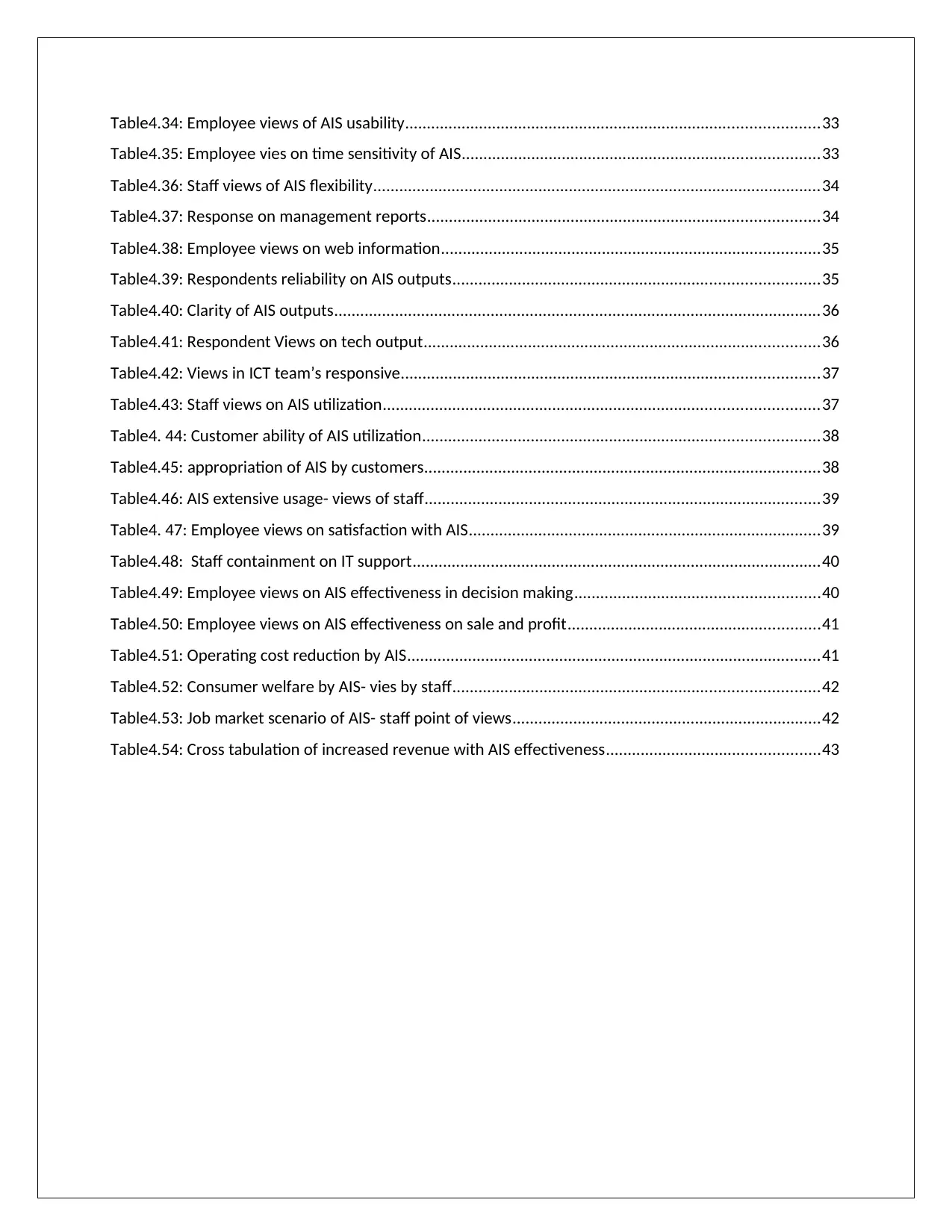
Table4.34: Employee views of AIS usability...............................................................................................33
Table4.35: Employee vies on time sensitivity of AIS..................................................................................33
Table4.36: Staff views of AIS flexibility.......................................................................................................34
Table4.37: Response on management reports..........................................................................................34
Table4.38: Employee views on web information.......................................................................................35
Table4.39: Respondents reliability on AIS outputs....................................................................................35
Table4.40: Clarity of AIS outputs................................................................................................................36
Table4.41: Respondent Views on tech output...........................................................................................36
Table4.42: Views in ICT team’s responsive................................................................................................37
Table4.43: Staff views on AIS utilization....................................................................................................37
Table4. 44: Customer ability of AIS utilization...........................................................................................38
Table4.45: appropriation of AIS by customers...........................................................................................38
Table4.46: AIS extensive usage- views of staff...........................................................................................39
Table4. 47: Employee views on satisfaction with AIS.................................................................................39
Table4.48: Staff containment on IT support..............................................................................................40
Table4.49: Employee views on AIS effectiveness in decision making........................................................40
Table4.50: Employee views on AIS effectiveness on sale and profit..........................................................41
Table4.51: Operating cost reduction by AIS...............................................................................................41
Table4.52: Consumer welfare by AIS- vies by staff....................................................................................42
Table4.53: Job market scenario of AIS- staff point of views.......................................................................42
Table4.54: Cross tabulation of increased revenue with AIS effectiveness.................................................43
Table4.35: Employee vies on time sensitivity of AIS..................................................................................33
Table4.36: Staff views of AIS flexibility.......................................................................................................34
Table4.37: Response on management reports..........................................................................................34
Table4.38: Employee views on web information.......................................................................................35
Table4.39: Respondents reliability on AIS outputs....................................................................................35
Table4.40: Clarity of AIS outputs................................................................................................................36
Table4.41: Respondent Views on tech output...........................................................................................36
Table4.42: Views in ICT team’s responsive................................................................................................37
Table4.43: Staff views on AIS utilization....................................................................................................37
Table4. 44: Customer ability of AIS utilization...........................................................................................38
Table4.45: appropriation of AIS by customers...........................................................................................38
Table4.46: AIS extensive usage- views of staff...........................................................................................39
Table4. 47: Employee views on satisfaction with AIS.................................................................................39
Table4.48: Staff containment on IT support..............................................................................................40
Table4.49: Employee views on AIS effectiveness in decision making........................................................40
Table4.50: Employee views on AIS effectiveness on sale and profit..........................................................41
Table4.51: Operating cost reduction by AIS...............................................................................................41
Table4.52: Consumer welfare by AIS- vies by staff....................................................................................42
Table4.53: Job market scenario of AIS- staff point of views.......................................................................42
Table4.54: Cross tabulation of increased revenue with AIS effectiveness.................................................43
Paraphrase This Document
Need a fresh take? Get an instant paraphrase of this document with our AI Paraphraser
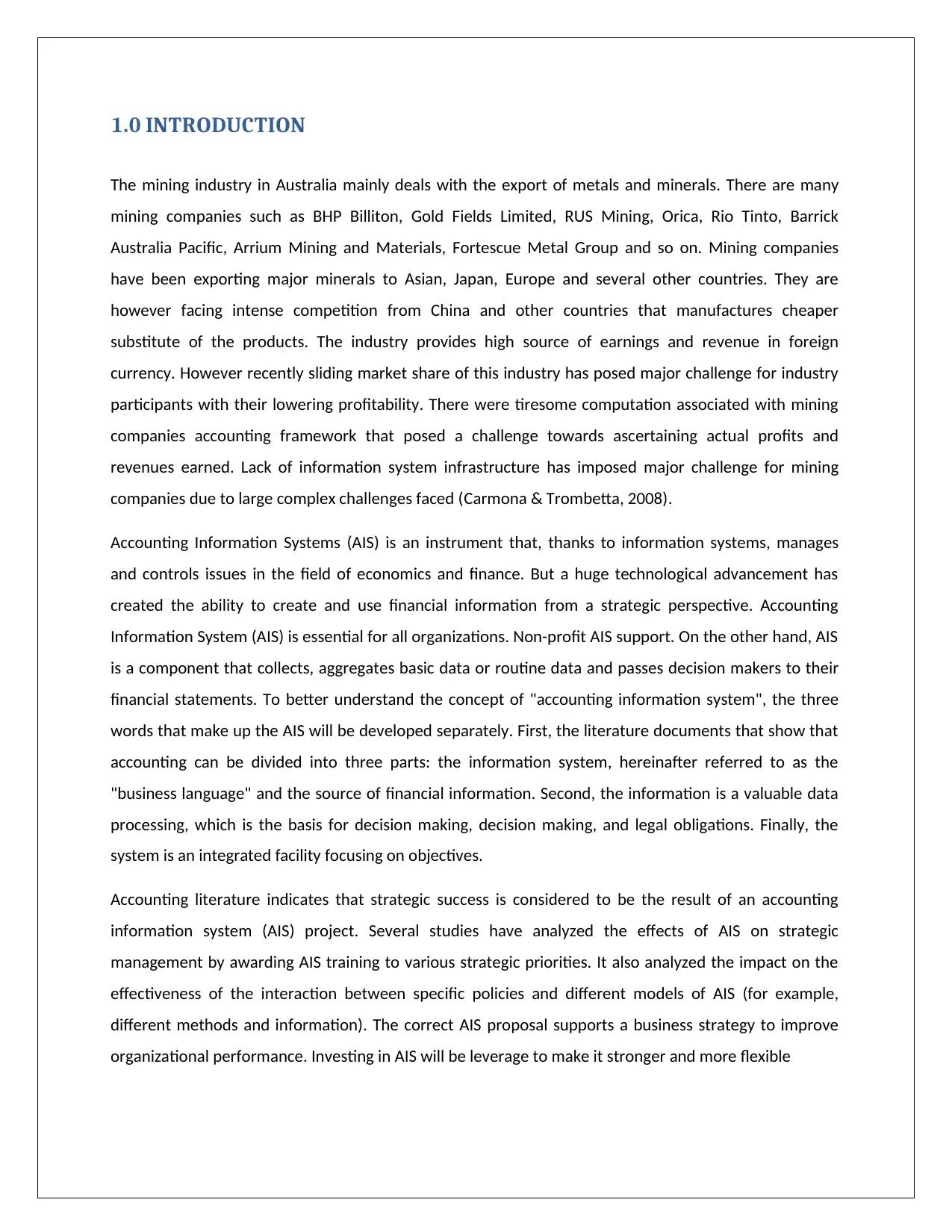
1.0 INTRODUCTION
The mining industry in Australia mainly deals with the export of metals and minerals. There are many
mining companies such as BHP Billiton, Gold Fields Limited, RUS Mining, Orica, Rio Tinto, Barrick
Australia Pacific, Arrium Mining and Materials, Fortescue Metal Group and so on. Mining companies
have been exporting major minerals to Asian, Japan, Europe and several other countries. They are
however facing intense competition from China and other countries that manufactures cheaper
substitute of the products. The industry provides high source of earnings and revenue in foreign
currency. However recently sliding market share of this industry has posed major challenge for industry
participants with their lowering profitability. There were tiresome computation associated with mining
companies accounting framework that posed a challenge towards ascertaining actual profits and
revenues earned. Lack of information system infrastructure has imposed major challenge for mining
companies due to large complex challenges faced (Carmona & Trombetta, 2008).
Accounting Information Systems (AIS) is an instrument that, thanks to information systems, manages
and controls issues in the field of economics and finance. But a huge technological advancement has
created the ability to create and use financial information from a strategic perspective. Accounting
Information System (AIS) is essential for all organizations. Non-profit AIS support. On the other hand, AIS
is a component that collects, aggregates basic data or routine data and passes decision makers to their
financial statements. To better understand the concept of "accounting information system", the three
words that make up the AIS will be developed separately. First, the literature documents that show that
accounting can be divided into three parts: the information system, hereinafter referred to as the
"business language" and the source of financial information. Second, the information is a valuable data
processing, which is the basis for decision making, decision making, and legal obligations. Finally, the
system is an integrated facility focusing on objectives.
Accounting literature indicates that strategic success is considered to be the result of an accounting
information system (AIS) project. Several studies have analyzed the effects of AIS on strategic
management by awarding AIS training to various strategic priorities. It also analyzed the impact on the
effectiveness of the interaction between specific policies and different models of AIS (for example,
different methods and information). The correct AIS proposal supports a business strategy to improve
organizational performance. Investing in AIS will be leverage to make it stronger and more flexible
The mining industry in Australia mainly deals with the export of metals and minerals. There are many
mining companies such as BHP Billiton, Gold Fields Limited, RUS Mining, Orica, Rio Tinto, Barrick
Australia Pacific, Arrium Mining and Materials, Fortescue Metal Group and so on. Mining companies
have been exporting major minerals to Asian, Japan, Europe and several other countries. They are
however facing intense competition from China and other countries that manufactures cheaper
substitute of the products. The industry provides high source of earnings and revenue in foreign
currency. However recently sliding market share of this industry has posed major challenge for industry
participants with their lowering profitability. There were tiresome computation associated with mining
companies accounting framework that posed a challenge towards ascertaining actual profits and
revenues earned. Lack of information system infrastructure has imposed major challenge for mining
companies due to large complex challenges faced (Carmona & Trombetta, 2008).
Accounting Information Systems (AIS) is an instrument that, thanks to information systems, manages
and controls issues in the field of economics and finance. But a huge technological advancement has
created the ability to create and use financial information from a strategic perspective. Accounting
Information System (AIS) is essential for all organizations. Non-profit AIS support. On the other hand, AIS
is a component that collects, aggregates basic data or routine data and passes decision makers to their
financial statements. To better understand the concept of "accounting information system", the three
words that make up the AIS will be developed separately. First, the literature documents that show that
accounting can be divided into three parts: the information system, hereinafter referred to as the
"business language" and the source of financial information. Second, the information is a valuable data
processing, which is the basis for decision making, decision making, and legal obligations. Finally, the
system is an integrated facility focusing on objectives.
Accounting literature indicates that strategic success is considered to be the result of an accounting
information system (AIS) project. Several studies have analyzed the effects of AIS on strategic
management by awarding AIS training to various strategic priorities. It also analyzed the impact on the
effectiveness of the interaction between specific policies and different models of AIS (for example,
different methods and information). The correct AIS proposal supports a business strategy to improve
organizational performance. Investing in AIS will be leverage to make it stronger and more flexible
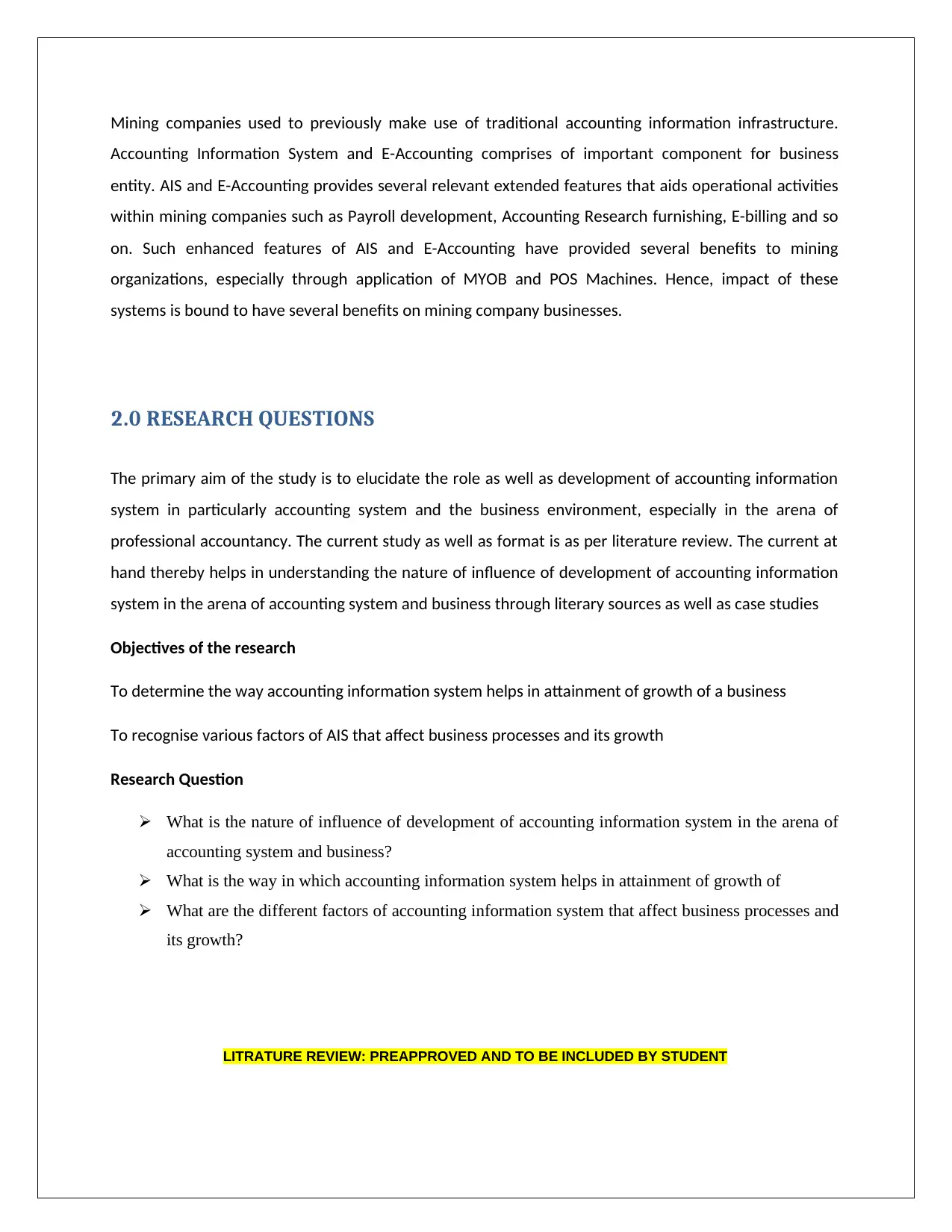
Mining companies used to previously make use of traditional accounting information infrastructure.
Accounting Information System and E-Accounting comprises of important component for business
entity. AIS and E-Accounting provides several relevant extended features that aids operational activities
within mining companies such as Payroll development, Accounting Research furnishing, E-billing and so
on. Such enhanced features of AIS and E-Accounting have provided several benefits to mining
organizations, especially through application of MYOB and POS Machines. Hence, impact of these
systems is bound to have several benefits on mining company businesses.
2.0 RESEARCH QUESTIONS
The primary aim of the study is to elucidate the role as well as development of accounting information
system in particularly accounting system and the business environment, especially in the arena of
professional accountancy. The current study as well as format is as per literature review. The current at
hand thereby helps in understanding the nature of influence of development of accounting information
system in the arena of accounting system and business through literary sources as well as case studies
Objectives of the research
To determine the way accounting information system helps in attainment of growth of a business
To recognise various factors of AIS that affect business processes and its growth
Research Question
What is the nature of influence of development of accounting information system in the arena of
accounting system and business?
What is the way in which accounting information system helps in attainment of growth of
What are the different factors of accounting information system that affect business processes and
its growth?
LITRATURE REVIEW: PREAPPROVED AND TO BE INCLUDED BY STUDENT
Accounting Information System and E-Accounting comprises of important component for business
entity. AIS and E-Accounting provides several relevant extended features that aids operational activities
within mining companies such as Payroll development, Accounting Research furnishing, E-billing and so
on. Such enhanced features of AIS and E-Accounting have provided several benefits to mining
organizations, especially through application of MYOB and POS Machines. Hence, impact of these
systems is bound to have several benefits on mining company businesses.
2.0 RESEARCH QUESTIONS
The primary aim of the study is to elucidate the role as well as development of accounting information
system in particularly accounting system and the business environment, especially in the arena of
professional accountancy. The current study as well as format is as per literature review. The current at
hand thereby helps in understanding the nature of influence of development of accounting information
system in the arena of accounting system and business through literary sources as well as case studies
Objectives of the research
To determine the way accounting information system helps in attainment of growth of a business
To recognise various factors of AIS that affect business processes and its growth
Research Question
What is the nature of influence of development of accounting information system in the arena of
accounting system and business?
What is the way in which accounting information system helps in attainment of growth of
What are the different factors of accounting information system that affect business processes and
its growth?
LITRATURE REVIEW: PREAPPROVED AND TO BE INCLUDED BY STUDENT
⊘ This is a preview!⊘
Do you want full access?
Subscribe today to unlock all pages.

Trusted by 1+ million students worldwide
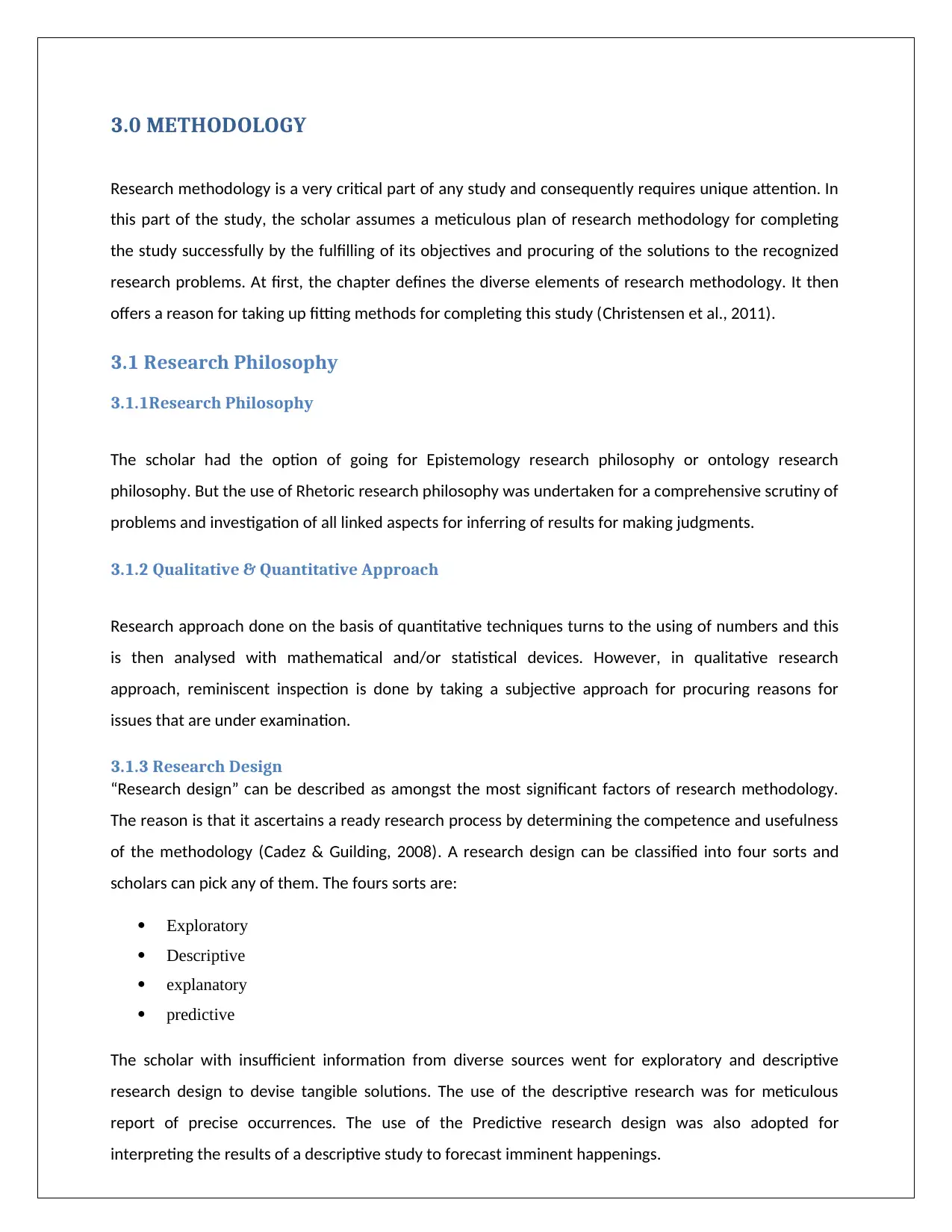
3.0 METHODOLOGY
Research methodology is a very critical part of any study and consequently requires unique attention. In
this part of the study, the scholar assumes a meticulous plan of research methodology for completing
the study successfully by the fulfilling of its objectives and procuring of the solutions to the recognized
research problems. At first, the chapter defines the diverse elements of research methodology. It then
offers a reason for taking up fitting methods for completing this study (Christensen et al., 2011).
3.1 Research Philosophy
3.1.1Research Philosophy
The scholar had the option of going for Epistemology research philosophy or ontology research
philosophy. But the use of Rhetoric research philosophy was undertaken for a comprehensive scrutiny of
problems and investigation of all linked aspects for inferring of results for making judgments.
3.1.2 Qualitative & Quantitative Approach
Research approach done on the basis of quantitative techniques turns to the using of numbers and this
is then analysed with mathematical and/or statistical devices. However, in qualitative research
approach, reminiscent inspection is done by taking a subjective approach for procuring reasons for
issues that are under examination.
3.1.3 Research Design
“Research design” can be described as amongst the most significant factors of research methodology.
The reason is that it ascertains a ready research process by determining the competence and usefulness
of the methodology (Cadez & Guilding, 2008). A research design can be classified into four sorts and
scholars can pick any of them. The fours sorts are:
Exploratory
Descriptive
explanatory
predictive
The scholar with insufficient information from diverse sources went for exploratory and descriptive
research design to devise tangible solutions. The use of the descriptive research was for meticulous
report of precise occurrences. The use of the Predictive research design was also adopted for
interpreting the results of a descriptive study to forecast imminent happenings.
Research methodology is a very critical part of any study and consequently requires unique attention. In
this part of the study, the scholar assumes a meticulous plan of research methodology for completing
the study successfully by the fulfilling of its objectives and procuring of the solutions to the recognized
research problems. At first, the chapter defines the diverse elements of research methodology. It then
offers a reason for taking up fitting methods for completing this study (Christensen et al., 2011).
3.1 Research Philosophy
3.1.1Research Philosophy
The scholar had the option of going for Epistemology research philosophy or ontology research
philosophy. But the use of Rhetoric research philosophy was undertaken for a comprehensive scrutiny of
problems and investigation of all linked aspects for inferring of results for making judgments.
3.1.2 Qualitative & Quantitative Approach
Research approach done on the basis of quantitative techniques turns to the using of numbers and this
is then analysed with mathematical and/or statistical devices. However, in qualitative research
approach, reminiscent inspection is done by taking a subjective approach for procuring reasons for
issues that are under examination.
3.1.3 Research Design
“Research design” can be described as amongst the most significant factors of research methodology.
The reason is that it ascertains a ready research process by determining the competence and usefulness
of the methodology (Cadez & Guilding, 2008). A research design can be classified into four sorts and
scholars can pick any of them. The fours sorts are:
Exploratory
Descriptive
explanatory
predictive
The scholar with insufficient information from diverse sources went for exploratory and descriptive
research design to devise tangible solutions. The use of the descriptive research was for meticulous
report of precise occurrences. The use of the Predictive research design was also adopted for
interpreting the results of a descriptive study to forecast imminent happenings.
Paraphrase This Document
Need a fresh take? Get an instant paraphrase of this document with our AI Paraphraser
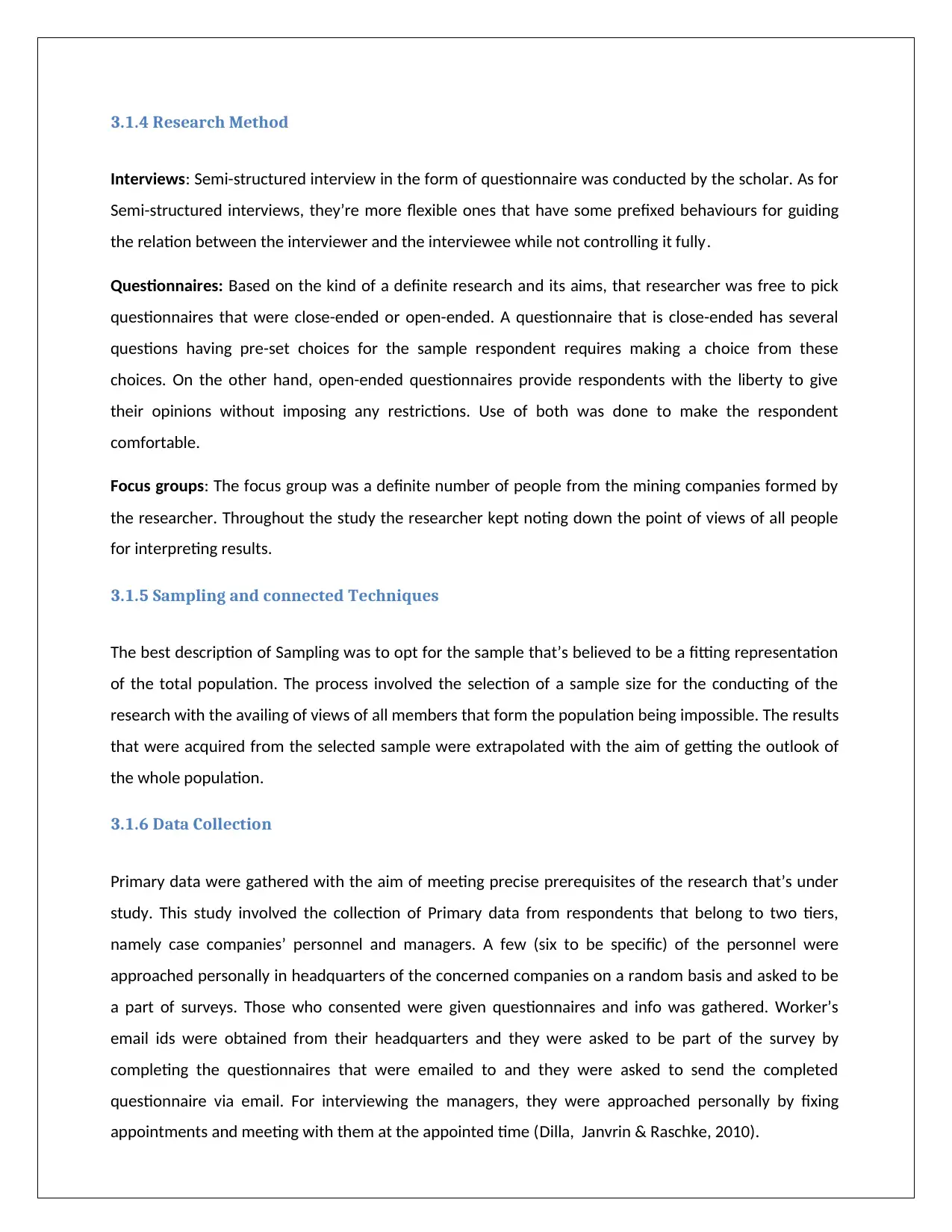
3.1.4 Research Method
Interviews: Semi-structured interview in the form of questionnaire was conducted by the scholar. As for
Semi-structured interviews, they’re more flexible ones that have some prefixed behaviours for guiding
the relation between the interviewer and the interviewee while not controlling it fully.
Questionnaires: Based on the kind of a definite research and its aims, that researcher was free to pick
questionnaires that were close-ended or open-ended. A questionnaire that is close-ended has several
questions having pre-set choices for the sample respondent requires making a choice from these
choices. On the other hand, open-ended questionnaires provide respondents with the liberty to give
their opinions without imposing any restrictions. Use of both was done to make the respondent
comfortable.
Focus groups: The focus group was a definite number of people from the mining companies formed by
the researcher. Throughout the study the researcher kept noting down the point of views of all people
for interpreting results.
3.1.5 Sampling and connected Techniques
The best description of Sampling was to opt for the sample that’s believed to be a fitting representation
of the total population. The process involved the selection of a sample size for the conducting of the
research with the availing of views of all members that form the population being impossible. The results
that were acquired from the selected sample were extrapolated with the aim of getting the outlook of
the whole population.
3.1.6 Data Collection
Primary data were gathered with the aim of meeting precise prerequisites of the research that’s under
study. This study involved the collection of Primary data from respondents that belong to two tiers,
namely case companies’ personnel and managers. A few (six to be specific) of the personnel were
approached personally in headquarters of the concerned companies on a random basis and asked to be
a part of surveys. Those who consented were given questionnaires and info was gathered. Worker’s
email ids were obtained from their headquarters and they were asked to be part of the survey by
completing the questionnaires that were emailed to and they were asked to send the completed
questionnaire via email. For interviewing the managers, they were approached personally by fixing
appointments and meeting with them at the appointed time (Dilla, Janvrin & Raschke, 2010).
Interviews: Semi-structured interview in the form of questionnaire was conducted by the scholar. As for
Semi-structured interviews, they’re more flexible ones that have some prefixed behaviours for guiding
the relation between the interviewer and the interviewee while not controlling it fully.
Questionnaires: Based on the kind of a definite research and its aims, that researcher was free to pick
questionnaires that were close-ended or open-ended. A questionnaire that is close-ended has several
questions having pre-set choices for the sample respondent requires making a choice from these
choices. On the other hand, open-ended questionnaires provide respondents with the liberty to give
their opinions without imposing any restrictions. Use of both was done to make the respondent
comfortable.
Focus groups: The focus group was a definite number of people from the mining companies formed by
the researcher. Throughout the study the researcher kept noting down the point of views of all people
for interpreting results.
3.1.5 Sampling and connected Techniques
The best description of Sampling was to opt for the sample that’s believed to be a fitting representation
of the total population. The process involved the selection of a sample size for the conducting of the
research with the availing of views of all members that form the population being impossible. The results
that were acquired from the selected sample were extrapolated with the aim of getting the outlook of
the whole population.
3.1.6 Data Collection
Primary data were gathered with the aim of meeting precise prerequisites of the research that’s under
study. This study involved the collection of Primary data from respondents that belong to two tiers,
namely case companies’ personnel and managers. A few (six to be specific) of the personnel were
approached personally in headquarters of the concerned companies on a random basis and asked to be
a part of surveys. Those who consented were given questionnaires and info was gathered. Worker’s
email ids were obtained from their headquarters and they were asked to be part of the survey by
completing the questionnaires that were emailed to and they were asked to send the completed
questionnaire via email. For interviewing the managers, they were approached personally by fixing
appointments and meeting with them at the appointed time (Dilla, Janvrin & Raschke, 2010).
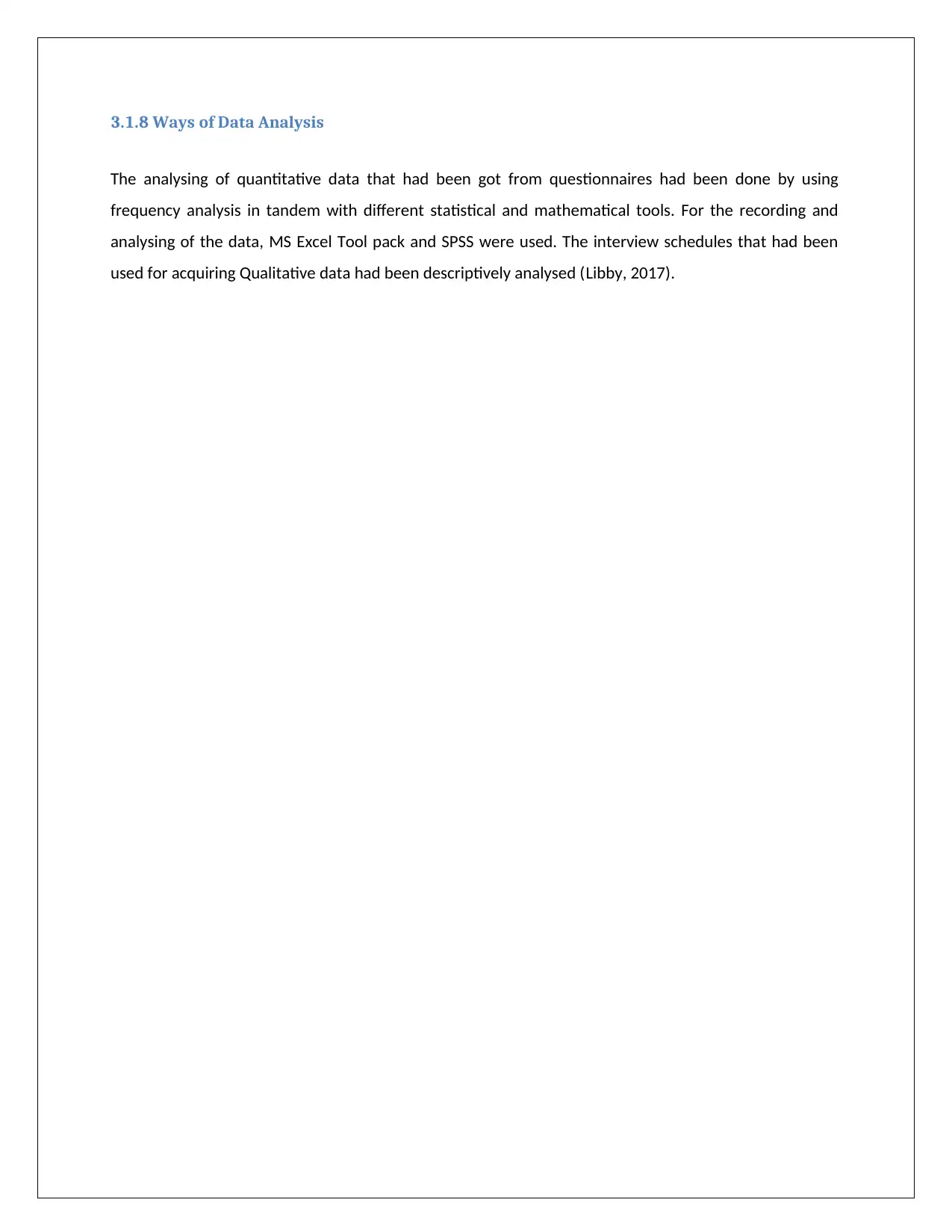
3.1.8 Ways of Data Analysis
The analysing of quantitative data that had been got from questionnaires had been done by using
frequency analysis in tandem with different statistical and mathematical tools. For the recording and
analysing of the data, MS Excel Tool pack and SPSS were used. The interview schedules that had been
used for acquiring Qualitative data had been descriptively analysed (Libby, 2017).
The analysing of quantitative data that had been got from questionnaires had been done by using
frequency analysis in tandem with different statistical and mathematical tools. For the recording and
analysing of the data, MS Excel Tool pack and SPSS were used. The interview schedules that had been
used for acquiring Qualitative data had been descriptively analysed (Libby, 2017).
⊘ This is a preview!⊘
Do you want full access?
Subscribe today to unlock all pages.

Trusted by 1+ million students worldwide
1 out of 58
Related Documents
Your All-in-One AI-Powered Toolkit for Academic Success.
+13062052269
info@desklib.com
Available 24*7 on WhatsApp / Email
![[object Object]](/_next/static/media/star-bottom.7253800d.svg)
Unlock your academic potential
Copyright © 2020–2025 A2Z Services. All Rights Reserved. Developed and managed by ZUCOL.





